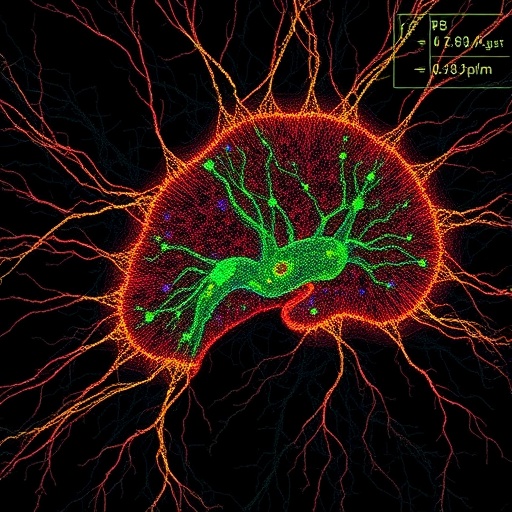Family Dynamics and Their Impact on Eating Disorders in Chinese Populations: A Comprehensive Exploration
In recent years, the spotlight has turned towards understanding the complexities of mental health issues, particularly those related to eating disorders (EDs). A recent systematic review and meta-synthesis, led by researchers Han, Cheung, and Corcoran, delves deeply into the intricacies of family functioning and its relationship with eating disorders in Chinese populations. This study not only encompasses a broad array of existing literature but also seeks to illuminate the unique cultural factors that influence the prevalence and manifestation of eating disorders in these communities.
The researchers have meticulously examined various studies that highlight the connections between family dynamics and the prevalence of eating disorders, particularly focusing on how familial relationships impact an individual’s mental health. The findings suggest that dysfunctional family environments—characterized by high levels of conflict, lack of emotional support, and rigid parenting styles—can significantly amplify the risk of developing eating disorders among young individuals in Chinese society.
Moreover, cultural expectations play a pivotal role in shaping attitudes towards body image and eating behaviors. In many Asian cultures, there is a strong emphasis on thinness, which is often erroneously equated with success and desirability. This societal pressure can lead to unhealthy eating habits, where individuals might resort to extreme dieting or purging behaviors in a bid to conform to these idealized body standards. The intersection of cultural norms and family expectations creates a complex web that can exacerbate these issues, particularly in adolescents who are more susceptible to external influences.
The systematic review highlights the need for contextualizing eating disorders within the family structure rather than viewing them as isolated phenomena. The research indicates that parental attitudes towards food and body image significantly shape a child’s self-perception and dietary choices. For instance, parents who express overt concern about their children’s eating habits, often with the intent of promoting health, may inadvertently instill anxiety about weight gain, triggering maladaptive eating behaviors.
In the realm of academic research, this meta-synthesis stands out for its rigorous methodology and comprehensive analysis. The authors employed systematic review techniques to gather data from multiple studies, ensuring a holistic view of family functioning’s impact on eating disorders. Their approach underscores the importance of merging qualitative and quantitative research methodologies to examine the multifactorial nature of eating disorders. This allows for a richer understanding of how family dynamics evolve in conjunction with individual psychological traits and cultural influences.
Notably, the study emphasizes the significance of preventative measures within families. The authors advocate for programs that encourage open communication and emotional support among family members, which can serve as protective factors against the development of eating disorders. By fostering an environment where individuals feel safe to express their thoughts and concerns, families can directly mitigate some of the stressors linked to disordered eating.
Interestingly, the findings of this research resonate beyond the confines of the Chinese population. They potentially have broader implications for understanding the role of family functioning in eating disorders across various cultural landscapes. The interplay between familial relationships and mental health is a universal phenomenon, and insights gleaned from this study can inform interventions in diverse sociocultural settings, promoting healthier family dynamics globally.
The study does not shy away from exploring the implications for clinical practice. Healthcare professionals working in mental health and nutrition can benefit by integrating family-based approaches into treatment protocols for eating disorders. Recognizing that individuals do not exist in a vacuum but are part of a larger family system can enhance the effectiveness of therapeutic interventions, leading to more sustainable recovery outcomes.
The research has also prompted discussions surrounding the adaptation of existing therapeutic frameworks to better suit cultural contexts. Evidence-based practices in Western countries may not be directly translatable to Chinese populations due to differences in family structure and cultural values. Thus, there is a call for culturally sensitive and contextually appropriate interventions that resonate with the unique experiences of Chinese families.
Furthermore, the authors stress the importance of ongoing research in this field. As eating disorders continue to evolve with societal changes, researchers must stay abreast of emerging trends and shifts in cultural attitudes towards health and body image. Longitudinal studies that explore these relationships over time could provide deeper insights into how family dynamics affect the onset and course of eating disorders.
There is also a growing recognition of the role of technology in shaping family interactions and individual behaviors. With the rise of social media and digital communication, family members are often more connected than ever. However, this increased connectivity can also lead to heightened scrutiny and pressure regarding appearances and lifestyle choices. As the digital landscape evolves, understanding these impacts will be crucial for developing effective prevention and treatment strategies.
In summary, Han, Cheung, and Corcoran’s research signifies a transformative step towards comprehensively understanding the interplay between family functioning and eating disorders within Chinese populations. This systematic review and meta-synthesis highlight critical avenues for future research and clinical practice, emphasizing the need for culturally informed family-based approaches to tackle the growing challenge of eating disorders in a globalized world.
As the discourse continues to evolve, it is vital for families, healthcare providers, and researchers to recognize the underlying factors that contribute to eating disorders. Only through collective efforts and a deeper understanding of family dynamics can we hope to forge pathways towards improved mental health outcomes for individuals grappling with these challenging conditions.
Subject of Research: Family functioning and eating disorders in Chinese populations
Article Title: Family functioning and eating disorders in Chinese populations: a systematic review and meta-synthesis.
Article References:
Han, X., Cheung, Mc. & Corcoran, J. Family functioning and eating disorders in Chinese populations: a systematic review and meta-synthesis.
J Eat Disord 13, 269 (2025). https://doi.org/10.1186/s40337-025-01453-1
Image Credits: AI Generated
DOI: https://doi.org/10.1186/s40337-025-01453-1
Keywords: Eating disorders, family functioning, Chinese populations, cultural dynamics, mental health interventions, systematic review.
Tags: Chinese populations and mental healthcultural factors in eating disordersdysfunctional family environments and EDsemotional support and eating disordersfamily dynamics and eating disordersfamily functioning and mental healthimpact of familial relationships on eating disordersprevalence of eating disorders in Chinarigid parenting styles and mental healthsocietal pressure and body imagethinness and cultural expectationsyouth mental health in Asian communities





